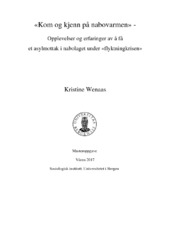| dc.contributor.author | Wenaas, Kristine Elholm | |
| dc.date.accessioned | 2017-06-16T11:12:33Z | |
| dc.date.available | 2017-06-16T11:12:33Z | |
| dc.date.issued | 2017-06-13 | |
| dc.date.submitted | 2017-06-12T22:00:26Z | |
| dc.identifier.uri | https://hdl.handle.net/1956/16004 | |
| dc.description.abstract | Som følger av en økning i antall asylankomster til Europa og Norge under «flyktningkrisen» i 2015, ble om lag 250 asylmottak opprettet i norske lokalsamfunn. Denne masteroppgaven baserer seg på 10 kvalitative intervju med lokale beboere i ett av disse lokalsamfunnene og undersøker deres forestillinger om og opplevelser av «flyktningkrisen» ved at det har blitt etablert et asylmottak i deres nabolag. Det teoretiske rammeverket anvendt for å analysere intervjuene er forskjellige samfunnsvitenskapelige og sosiologiske perspektiv på symbolsk grensesetting. Jeg har blant annet tatt i bruk Lamont og Molnár (2002) sin forståelse av symbolske grenser og Lamont og Aksartova (2002) sin forståelse av hverdagskosmopolitisme og multiple kosmopolitismer. Studien plasserer seg innenfor forskning på majoritetsnordmenns forestillinger om, og erfaringer av, innvandring, integrering og etnisk, kulturelt og religiøst mangfold (jf. Bygnes 2012a; Hagelund 2003b; Gullestad 2002; Vassenden 2007). Basert på analyser av intervjumaterialet og i samspill med mine valgte teoretiske perspektiver, argumenterer jeg for at symbolske grensesettingsprosesser og orientering mot kosmopolitisme er praksiser som forekommer både mellom informantene og beboerne på asylmottaket og mellom de lokale beboerne seg imellom. Informantene forteller at flere lokale beboere var usikre til etableringen fordi man ikke visste hvem som kom og om, og i så fall hvordan, dette kunne påvirke lokalsamfunnet. Flere av informantene fortalte også at de var usikre selv. Inspirert av Blumers (1954) «sensitizing concept», identifiserer jeg informantenes ulike fortellinger av «usikkerhet». Jeg undersøker hvordan «usikkerhet» blir gitt ulikt meningsinnhold, samt benyttes som en symbolsk grensemarkør og som en symbolsk brobygger overfor beboerne på asylmottaket og overfor andre lokale beboere. Jeg finner Hagelund (2003b) sitt konsept om «anstendighet» nyttige i analysen i samtaler om innvandring, integrering og en økning i mangfold. Jeg argumenterer for at «usikkerhet» av informantene gis ulikt meningsinnhold, samt at grensene for hva som anses som en anstendig usikkerhet varierer mellom informantene. | en_US |
| dc.description.abstract | Due to an increase in numbers of asylum seeker arrivals to Europe and Norway under the «refugee crisis» in 2015, about 250 reception centres for asylum seekers were established in Norway. This master thesis is based on 10 qualitative interviews to examine expectations and experiences of local residents about “the refugee crisis” and the establishment of a reception centre in their neighbourhood. Different perspectives on symbolic boundaries inform the theoretical framework applied to analyse the interviews across social sciences and sociology. Among others, Lamont and Molnár’s (2002) understanding of symbolic boundaries and Lamont and Aksartovas’ (2002) understanding of ordinary cosmopolitanisms and multiple cosmopolitanisms have been particularly influential to this thesis’ analytical framework. This study is situated within the broader field of investigations into the majority population’s expectations towards, and experience of, immigration, integration and ethnical, cultural and religious diversity in Norway (see for example Bygnes 2012a; Hagelund 2003b; Gullestad 2002; Vassenden 2007). Based on the analysis of the interview material and my choices of theoretical perspectives, I argue that the processes of symbolic boundary making and orientation towards cosmopolitism are to be found both between the informants and the inhabitants of the reception centre and between the members of the local community. The informants recounted that many of the members of the local community were uncertain about a new reception centre because they did not know who was coming and how this might influence their local community. Inspired by Blumer’s (1954) «sensitizing concept», I identify the informant’s different narratives of «uncertainty». I examine how «uncertainty» is given meaning by the informants and is used as both a symbolic marker, as well as a bridge, between the informants and the inhabitants of the reception centre, as well between the informants and other members of the local community. I find Hagelund’s (2003b) concept of «decency» as a useful tool in the analysis of topics of immigration, integration and increase in diversity. I argue that the meaning of «uncertainty» vary among the informants, such that defining the limits of what constitutes decent uncertainty varies between the informants. | en_US |
| dc.language.iso | nob | eng |
| dc.publisher | The University of Bergen | eng |
| dc.title | «Kom og kjenn på nabovarmen» - Opplevelser og erfaringer av å få et asylmottak i nabolaget under «flyktningkrisen» | eng |
| dc.type | Master thesis | en_US |
| dc.date.updated | 2017-06-12T22:00:26Z | |
| dc.rights.holder | Copyright the author. All rights reserved. | en_US |
| dc.description.localcode | SOS360 | |
| dc.description.localcode | MASV-SOS | |
| dc.subject.nus | 732106 | eng |
| fs.subjectcode | SOS360 | |
| fs.unitcode | 15-11-00 | |
